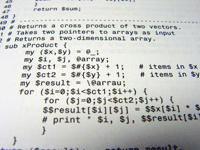What you should already know
Before you continue you should have a basic understanding of the
following:
- WWW, HTML and the basics of building Web pages
- CSS
- JavaScript
If you want to study these subjects first, find the tutorials on our Home Page.
DHTML is NOT a W3C Standard
DHTML stands for Dynamic HTML.
DHTML is not a standard defined by the World Wide Web Consortium (W3C). DHTML
is a "marketing term" - used by Netscape and Microsoft to describe the new
technologies the 4.x generation browsers would support.
DHTML is a combination of technologies used to create dynamic Web sites.
To most people DHTML means a combination of HTML 4.0, Style Sheets and
JavaScript.
W3C once said: "Dynamic HTML is a term used by some vendors to describe
the combination of HTML, style sheets and scripts that allows documents to be
animated."
DHTML Technologies
With DHTML a Web developer can control how to display and position HTML
elements in a browser window.
HTML 4.0
With HTML 4.0 all formatting can be moved out of the HTML document and into a
separate style sheet. Because HTML 4.0 separates the presentation of the
document from its structure, we have total control of presentation layout
without messing up the document content.
Cascading Style Sheets (CSS)
With CSS we have a style and layout model for HTML documents.
CSS was a breakthrough in Web design because it allowed developers to control
the style and layout of multiple Web pages all at once. As a Web developer you
can define a style for each HTML element and apply it to as many Web pages as
you want. To make a global change, simply change the style, and all elements in
the Web are updated automatically.
The Document Object Model (DOM)
DOM stands for the Document Object Model.
The HTML DOM is the Document Object Model for HTML.
The HTML DOM defines a standard set of objects for HTML, and a standard way
to access and manipulate HTML objects.
"The W3C Document Object Model (DOM) is a platform and language neutral
interface that allows programs and scripts to dynamically access and update the
content, structure, and style of a document".
JavaScript (and VBScript)
Allows you to write code to control all HTML elements.
DHTML technologies in Netscape 4.x and Internet Explorer 4.x:
| Netscape Navigator 4.x |
Cross-Browser DHTML |
Internet Explorer 4.x |
- JSS (JavaScript Style Sheets) (allows you to control how different HTML
elements will be displayed)
- Layers (allows you to control element positioning and visibility)
|
- CSS1
- CSS2 (allows you to control how different HTML elements will be displayed)
- CSS Positioning (allows you to control element positioning and visibility)
- JavaScript
|
- Visual Filters (allow you to apply visual effects to text and graphics)
- Dynamic CSS (allows you to control element positioning and visibility)
|
Note: Problems with coding DHTML technologies WILL occur as long as
each browser creates its own proprietary features and technology that is not
supported by other browsers. A Web page may look great in one browser and
horrible in another.
|



